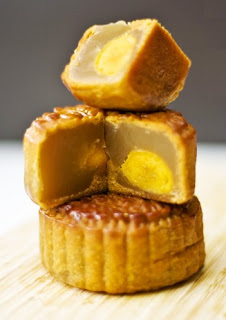In the present day, Chinese people will generally celebrate the Moon Cake Festival with entertainment, feasting and moon-gazing, but the most important and central element of the festival is the moon cake. Moon cakes are around the size of a palm and can be either round or square in shape. Inside traditional moon cakes is lotus seed paste with one or more yolks from salted duck eggs placed within the paste. These represent the full moon or phases of the moon and the filling is encased in a golden brown crust that is usually decorated with symbols of the festival, either by hand or more commonly by moulds.
The moon cake is a delicacy that is so far from normality in the UK that it highlights just how different the Chinese and British cultures are. I believe that everyone should be adventurous with what they choose to eat and if you have the opportunity to try something new, you should go for it and experiment! You may even gain some insight into the history of another culture in addition to a new favourite food.
Those who have tasted a moon cake may describe it as an acquired taste; however, I think they are extraordinary. Since the filling is a paste and the crust is only thin, moon cakes are quite dense and very rich in flavour. The saltiness from the egg yolk contrasts with the sweet lotus paste, which gives an enjoyable balance of flavours. Typically, the moon cake is cut into segments and shared around, since a few pieces can be rather filling.
Along with lotus seed paste; red bean and black bean pastes are also common fillings and over the years, a vast range of moon cakes have been created with differing fillings and crusts. It is not uncommon to now find dates, nuts, fruit, Chinese sausage, pumpkin, yam or seeds in moon cakes. They are fairly difficult to make, so most choose to buy them when they become available in Chinese bakeries or supermarkets around mid-August.

Although moon cakes are innately unique and essential to the Moon Cake Festival, their existence has played a more legendary role in Chinese history. The story slightly resembles the Trojan War (a Chinese one!) with moon cakes embodying the ‘Trojan Horse’ which brought about a revolution. During the Yuan Dynasty (from 1280-1368 A.D.), China was under the oppressive rule of the Mongols for almost a century. In this time, the common Chinese suffered extensively and any attempt of a rebellion was cruelly punished. An intricate plan was therefore formulated to overthrow the Mongols and the Chinese baked hundreds of moon cakes during the Mid-Autumn Festival in preparation. However, instead of the fillings we would expect to find today, messages inciting people to join an impending rebellion were hidden inside and they were distributed among family and friends. As the Mongolian people did not eat moon cakes and paid no attention to them, they were completely taken aback by the well designed rebellion and it lead to the abrupt demise of the Yuan Dynasty.
 |
| A giant Moon Cake created for the Mid-Autumn Festival |





No comments:
Post a Comment